2020 NISSAN 370Z warning
[x] Cancel search: warningPage 42 of 455

1-20Safety — Seats, seat belts and supplemental restraint system
this vehicle. Do not attempt to
hold a child in your lap or arms.
. Roadster models do not have an
anchor for a top tether strap
required for most child restraints.
Never let children who require the
use of rear or front-facing child
restraints ride in this vehicle.
. Larger children need special pro-
tection. The vehicle’s seat belts
may not fit them properly. The
shoulder belt may come too close
to the face or neck. The lap belt
may not fit over their small hip
bones. In an accident, an impro-
perly fitting seat belt could cause
serious or fatal injury. Always use
appropriate child restraints.
SSS0099
SSS0100
PRECAUTIONS ON CHILD RE-
STRAINTS
WARNING
.Failure to follow the warnings
and instructions for proper use
and installation of child restraints
could result in serious injury or
death of a child or other passen-
gers in a sudden stop or collision:
— The child restraint must be
used and installed properly.
Always follow all of the child
restraint manufacturer’s in-
structions for installation and
use.
— Infants and children should never be held on anyone’s
lap. Even the strongest adult
cannot resist the forces of a
collision.
— Do not put a seat belt around both a child and another pas-
senger.
— Even with the NISSAN Ad- vanced Air Bag System, never
install a rear-facing child re-
straint in the front seat. An
inflating air bag could ser-
CHILD RESTRAINTS
Page 43 of 455
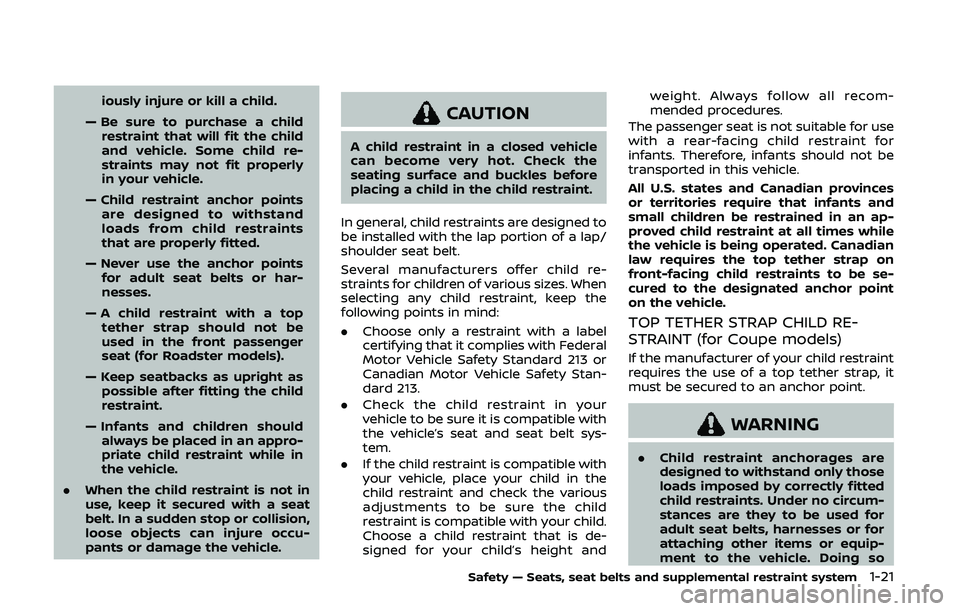
iously injure or kill a child.
— Be sure to purchase a child restraint that will fit the child
and vehicle. Some child re-
straints may not fit properly
in your vehicle.
— Child restraint anchor points are designed to withstand
loads from child restraints
that are properly fitted.
— Never use the anchor points for adult seat belts or har-
nesses.
— A child restraint with a top tether strap should not be
used in the front passenger
seat (for Roadster models).
— Keep seatbacks as upright as possible after fitting the child
restraint.
— Infants and children should always be placed in an appro-
priate child restraint while in
the vehicle.
. When the child restraint is not in
use, keep it secured with a seat
belt. In a sudden stop or collision,
loose objects can injure occu-
pants or damage the vehicle.CAUTION
A child restraint in a closed vehicle
can become very hot. Check the
seating surface and buckles before
placing a child in the child restraint.
In general, child restraints are designed to
be installed with the lap portion of a lap/
shoulder seat belt.
Several manufacturers offer child re-
straints for children of various sizes. When
selecting any child restraint, keep the
following points in mind:
. Choose only a restraint with a label
certifying that it complies with Federal
Motor Vehicle Safety Standard 213 or
Canadian Motor Vehicle Safety Stan-
dard 213.
. Check the child restraint in your
vehicle to be sure it is compatible with
the vehicle’s seat and seat belt sys-
tem.
. If the child restraint is compatible with
your vehicle, place your child in the
child restraint and check the various
adjustments to be sure the child
restraint is compatible with your child.
Choose a child restraint that is de-
signed for your child’s height and weight. Always follow all recom-
mended procedures.
The passenger seat is not suitable for use
with a rear-facing child restraint for
infants. Therefore, infants should not be
transported in this vehicle.
All U.S. states and Canadian provinces
or territories require that infants and
small children be restrained in an ap-
proved child restraint at all times while
the vehicle is being operated. Canadian
law requires the top tether strap on
front-facing child restraints to be se-
cured to the designated anchor point
on the vehicle.
TOP TETHER STRAP CHILD RE-
STRAINT (for Coupe models)
If the manufacturer of your child restraint
requires the use of a top tether strap, it
must be secured to an anchor point.
WARNING
. Child restraint anchorages are
designed to withstand only those
loads imposed by correctly fitted
child restraints. Under no circum-
stances are they to be used for
adult seat belts, harnesses or for
attaching other items or equip-
ment to the vehicle. Doing so
Safety — Seats, seat belts and supplemental restraint system1-21
Page 45 of 455
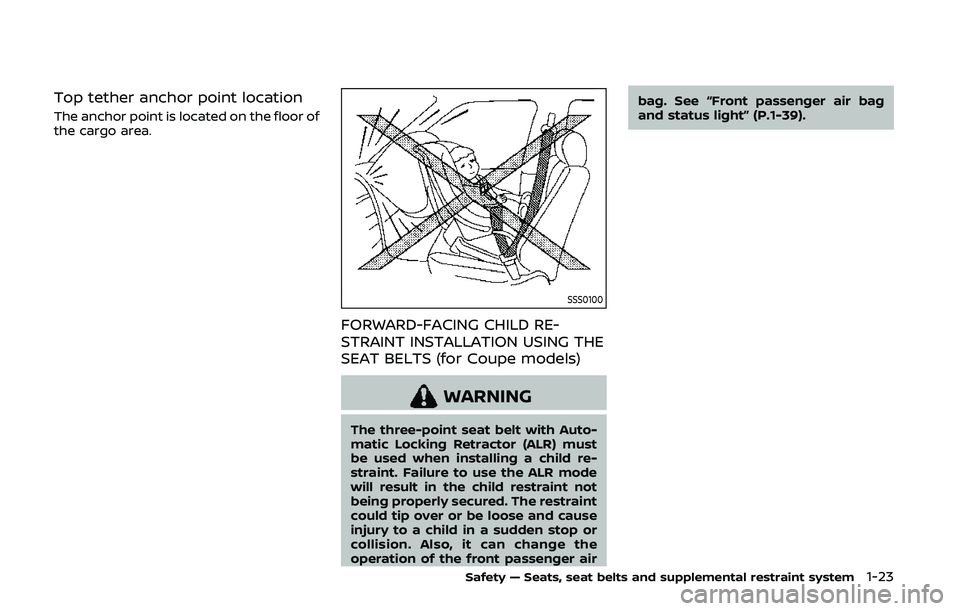
Top tether anchor point location
The anchor point is located on the floor of
the cargo area.
SSS0100
FORWARD-FACING CHILD RE-
STRAINT INSTALLATION USING THE
SEAT BELTS (for Coupe models)
WARNING
The three-point seat belt with Auto-
matic Locking Retractor (ALR) must
be used when installing a child re-
straint. Failure to use the ALR mode
will result in the child restraint not
being properly secured. The restraint
could tip over or be loose and cause
injury to a child in a sudden stop or
collision. Also, it can change the
operation of the front passenger airbag. See “Front passenger air bag
and status light” (P.1-39).
Safety — Seats, seat belts and supplemental restraint system1-23
Page 46 of 455
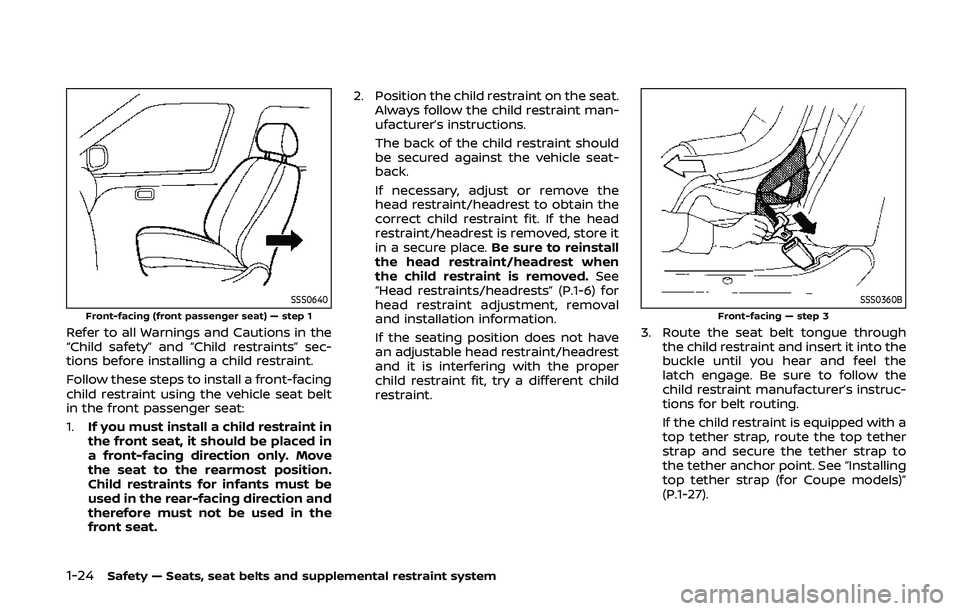
1-24Safety — Seats, seat belts and supplemental restraint system
SSS0640Front-facing (front passenger seat) — step 1
Refer to all Warnings and Cautions in the
“Child safety” and “Child restraints” sec-
tions before installing a child restraint.
Follow these steps to install a front-facing
child restraint using the vehicle seat belt
in the front passenger seat:
1.If you must install a child restraint in
the front seat, it should be placed in
a front-facing direction only. Move
the seat to the rearmost position.
Child restraints for infants must be
used in the rear-facing direction and
therefore must not be used in the
front seat. 2. Position the child restraint on the seat.
Always follow the child restraint man-
ufacturer’s instructions.
The back of the child restraint should
be secured against the vehicle seat-
back.
If necessary, adjust or remove the
head restraint/headrest to obtain the
correct child restraint fit. If the head
restraint/headrest is removed, store it
in a secure place. Be sure to reinstall
the head restraint/headrest when
the child restraint is removed. See
“Head restraints/headrests” (P.1-6) for
head restraint adjustment, removal
and installation information.
If the seating position does not have
an adjustable head restraint/headrest
and it is interfering with the proper
child restraint fit, try a different child
restraint.
SSS0360BFront-facing — step 3
3. Route the seat belt tongue through
the child restraint and insert it into the
buckle until you hear and feel the
latch engage. Be sure to follow the
child restraint manufacturer’s instruc-
tions for belt routing.
If the child restraint is equipped with a
top tether strap, route the top tether
strap and secure the tether strap to
the tether anchor point. See “Installing
top tether strap (for Coupe models)”
(P.1-27).
Page 49 of 455
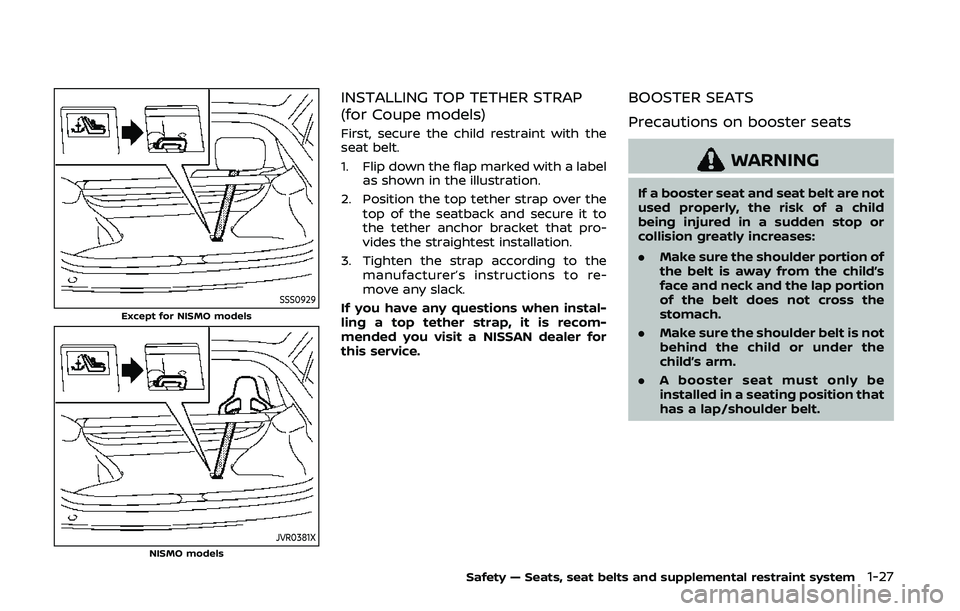
SSS0929Except for NISMO models
JVR0381XNISMO models
INSTALLING TOP TETHER STRAP
(for Coupe models)
First, secure the child restraint with the
seat belt.
1. Flip down the flap marked with a labelas shown in the illustration.
2. Position the top tether strap over the top of the seatback and secure it to
the tether anchor bracket that pro-
vides the straightest installation.
3. Tighten the strap according to the manufacturer’s instructions to re-
move any slack.
If you have any questions when instal-
ling a top tether strap, it is recom-
mended you visit a NISSAN dealer for
this service.
BOOSTER SEATS
Precautions on booster seats
WARNING
If a booster seat and seat belt are not
used properly, the risk of a child
being injured in a sudden stop or
collision greatly increases:
. Make sure the shoulder portion of
the belt is away from the child’s
face and neck and the lap portion
of the belt does not cross the
stomach.
. Make sure the shoulder belt is not
behind the child or under the
child’s arm.
. A booster seat must only be
installed in a seating position that
has a lap/shoulder belt.
Safety — Seats, seat belts and supplemental restraint system1-27
Page 51 of 455
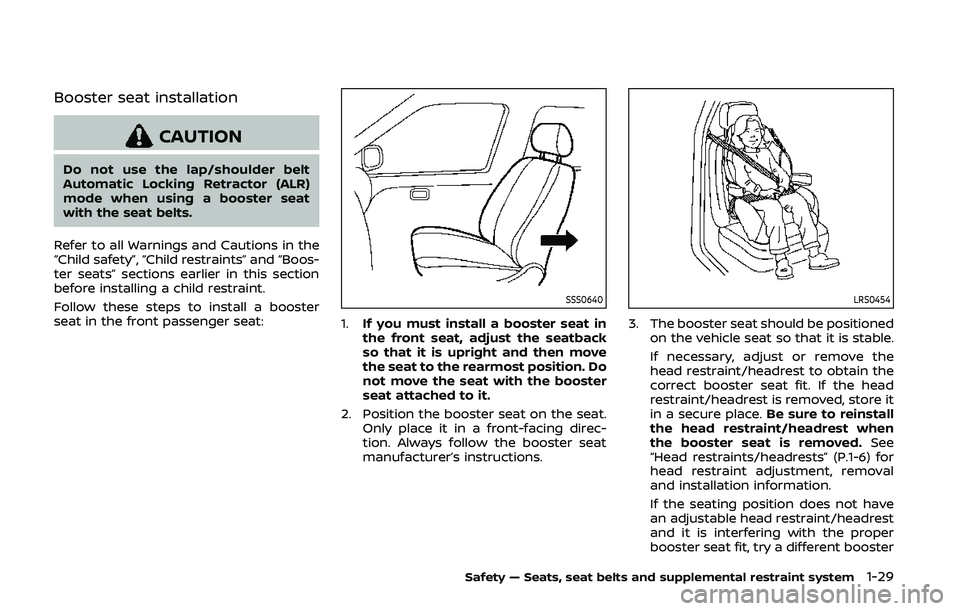
Booster seat installation
CAUTION
Do not use the lap/shoulder belt
Automatic Locking Retractor (ALR)
mode when using a booster seat
with the seat belts.
Refer to all Warnings and Cautions in the
“Child safety”, “Child restraints” and “Boos-
ter seats” sections earlier in this section
before installing a child restraint.
Follow these steps to install a booster
seat in the front passenger seat:
SSS0640
1. If you must install a booster seat in
the front seat, adjust the seatback
so that it is upright and then move
the seat to the rearmost position. Do
not move the seat with the booster
seat attached to it.
2. Position the booster seat on the seat. Only place it in a front-facing direc-
tion. Always follow the booster seat
manufacturer’s instructions.
LRS0454
3. The booster seat should be positioned
on the vehicle seat so that it is stable.
If necessary, adjust or remove the
head restraint/headrest to obtain the
correct booster seat fit. If the head
restraint/headrest is removed, store it
in a secure place. Be sure to reinstall
the head restraint/headrest when
the booster seat is removed. See
“Head restraints/headrests” (P.1-6) for
head restraint adjustment, removal
and installation information.
If the seating position does not have
an adjustable head restraint/headrest
and it is interfering with the proper
booster seat fit, try a different booster
Safety — Seats, seat belts and supplemental restraint system1-29
Page 52 of 455
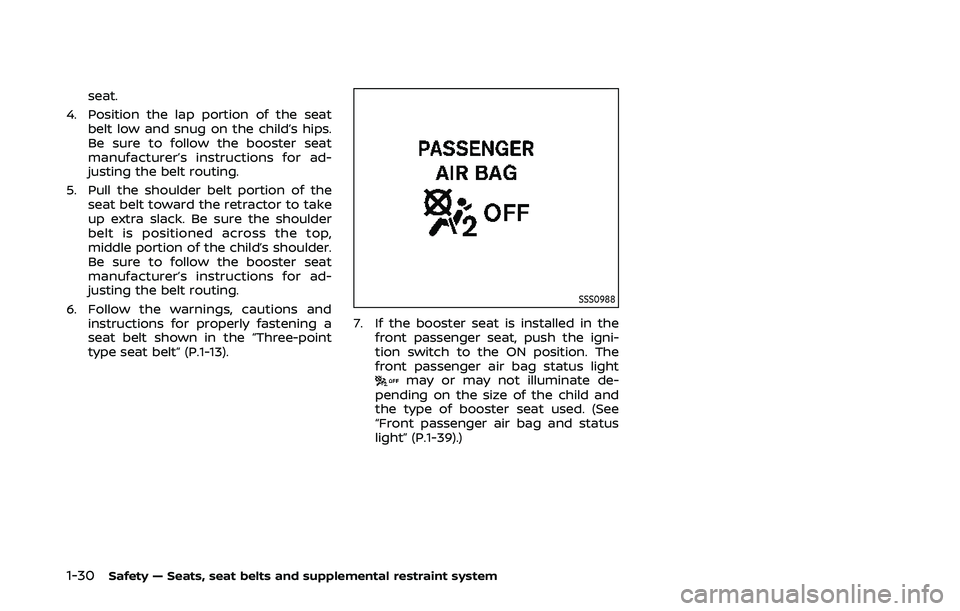
1-30Safety — Seats, seat belts and supplemental restraint system
seat.
4. Position the lap portion of the seat belt low and snug on the child’s hips.
Be sure to follow the booster seat
manufacturer’s instructions for ad-
justing the belt routing.
5. Pull the shoulder belt portion of the seat belt toward the retractor to take
up extra slack. Be sure the shoulder
belt is positioned across the top,
middle portion of the child’s shoulder.
Be sure to follow the booster seat
manufacturer’s instructions for ad-
justing the belt routing.
6. Follow the warnings, cautions and instructions for properly fastening a
seat belt shown in the “Three-point
type seat belt” (P.1-13).
SSS0988
7. If the booster seat is installed in thefront passenger seat, push the igni-
tion switch to the ON position. The
front passenger air bag status light
may or may not illuminate de-
pending on the size of the child and
the type of booster seat used. (See
“Front passenger air bag and status
light” (P.1-39).)
Page 53 of 455

PRECAUTIONS ON SUPPLEMENTAL
RESTRAINT SYSTEM
This Supplemental Restraint System (SRS)
section contains important information
concerning the following systems.
.Driver and passenger supplemental
front-impact air bag (NISSAN Ad-
vanced Air Bag System)
. Front seat-mounted side-impact sup-
plemental air bag
. Roof-mounted curtain side-impact
and rollover supplemental air bag
(Coupe models)
. Door-mounted curtain side-impact
supplemental air bag (Roadster mod-
els)
. Seat belt with pretensioner
Supplemental front-impact air bag sys-
tem: The NISSAN Advanced Air Bag Sys-
tem can help cushion the impact force to
the head and chest of the driver and front
passenger in certain frontal collisions.
Front seat-mounted side-impact sup-
plemental air bag system: This system
can help cushion the impact force to the
chest and pelvis area of the driver and
front passenger in certain side impact
collisions. The front seat side-impact
supplemental air bags are designed to
inflate on the side where the vehicle is
impacted. Roof-mounted curtain side-impact and
rollover supplemental air bag system
(for Coupe models):
This system can help
cushion the impact force to the head of
the driver and front passenger in certain
side-impact or rollover collisions. In a
side-impact, the curtain air bags are
designed to inflate on the side where
the vehicle is impacted. In a rollover,
curtain air bags on both sides are de-
signed to inflate and remain inflated for a
short time.
Curtain air bags are also designed to
inflate in certain types of rollover colli-
sions or near rollovers. As a result, certain
vehicle movements may cause the cur-
tain air bags to inflate.
Door-mounted curtain side-impact
supplemental air bag system (for Road-
ster models): This system can help cush-
ion the impact force to the heads of the
driver and front passenger in certain side
impact collisions. The curtain air bags are
designed to inflate on the side where the
vehicle is impacted.
These supplemental restraint systems are
designed to supplement the crash pro-
tection provided by the driver and pas-
senger seat belts and are not a
substitute for them. Seat belts should
always be correctly worn and the occu-
pant seated a suitable distance away from the steering wheel, instrument pa-
nel and door finishers. (See “Seat belts”
(P.1-10) for instructions and precautions
on seat belt usage.)
The supplemental air bags operate only
when the ignition switch is in the ON
position.
After pushing the ignition switch to the
ON position, the supplemental air bag
warning light illuminates. The supple-
mental air bag warning light will turn
off after about 7 seconds if the systems
are operational.
Safety — Seats, seat belts and supplemental restraint system1-31
SUPPLEMENTAL RESTRAINT SYSTEM